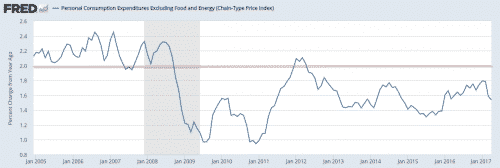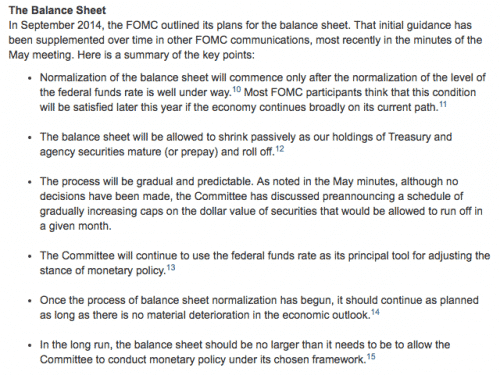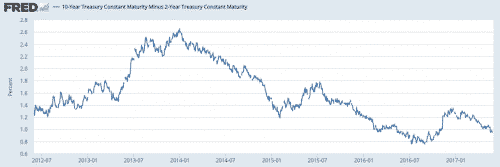On the Fed’s pause due to dual-barrelled monetary tightening
Fed Governor Jerome Powell recommended a June hike and 2017 balance sheet reductions in one of the last public speeches by a Fed official before the June FOMC meeting. When the Fed follows Powell’s game plan, we will be in the unchartered waters of dual-barrelled tightening, with the attendant risks that entails. Some comments below
First, let’s recognize that, in fulfilling its dual mandate on inflation and employment, the Fed is fully focused on employment data right now and is looking through inflation data. The core PCE inflation data point that the Fed uses as its target inflation metric has been below the Fed’s stated 2% target for 58 straight months now. And there are no signs it is heading to target.
Yet Jerome Powell claimed it statements this morning that there were good reasons to predict a rebound.
the FOMC interprets price stability to mean inflation of 2 percent as measured by the price index for personal consumption expenditures (PCE). This objective is symmetric, so the Committee would be concerned if inflation were to run persistently above or below this target. Inflation has run below 2 percent for most of the period since the financial crisis, reflecting generally soft economic conditions as well as transitory factors such as the earlier declines in energy prices. But over the past two years, inflation has moved gradually closer to our objective…Core inflation, which excludes food and energy prices, has proven historically to be a better indicator of where overall inflation is heading, although it, too, can be affected by transitory factors such as import prices. Core inflation was 1.5 percent for the 12 months through April. This measure has also risen since 2015, although its gradual increase appears to have paused because of weak inflation readings for March and April. Some of the recent weakness can be explained by transitory factors. And there are good reasons to expect that inflation will resume its gradual rise. [Emphasis added]
At the same time, employment data are good, with the latest ADP figure of 253,000 jobs added to private payrolls ahead of expectations of 180,000. Jobless claims data released this morning also show no real signs of weakness despite a small uptick to 248,000. The 4-week average is still 238,000. Tomorrow’s jobs report is the last important data point we will get on this front. The number is expected to be good. And so, given that even doves like Lael Brainard have indicated they favour hikes, we can conclude that the Fed will use the employment picture to justify continued rate hikes. inflation data will not be an impediment to future hikes, though softness might slow the pace of hikes.
Now, Powell is moving the discussion past June to talk about balance sheet reduction – what I will call reverse QE. We should see his policy speech as official Fed policy given how specific he was in announcing how reverse QE is going to proceed.
He also says this reverse QE should start later this year, with the path of interest rate hikes dependent on how markets react to the initial balance sheet run-off when the Fed ends reinvestment.
Though it has taken us a while to get here, this is all very predictable. I first reported on James Bullard’s rationale for reducing the balance sheet in February, writing that “a Fed that raises rates too quickly is one that flattens the yield curve and chokes off the recovery. And with the real recovery floundering, risk assets like high yield and equities would be hit hard. So, if the economic cycle continues, at some point the Fed will have to reassess its present view that focusing on interest rates instead of the balance sheet still makes sense.”
And, of course, by April the Fed had come around to Bullard’s point of view. We should see Powell’s comments as confirmation of this.
The problem is that curve flattening has continued apace. We are now back below 100 basis points on the 2-10 spread, the most common measure of yield curve steepness. That is very flat. And it is a sign of tightening monetary conditions.
Now, my view is that we should see the balance sheet reduction of reverse QE as an additional form of monetary tightening – double-barrelled tightening if you will. Just as quantitative easing was considered an additional marker of easing, reverse QE is a supplemental sign of tightening. And what it implies – when we get there – is that the Fed will be signalling even tighter monetary policy to markets.
Fed hikes = tightening
Fed hikes and balance sheet reduction = even more tightening
Bottom line: Since we already see both inflation below target and market indications of tightening financial conditions via the flat yield curve, I believe the Fed will be forced to pause at some point. It will not be able to deliver on its forecast of rate hikes. That is bullish for Treasuries though not necessarily for other fixed income markets.



Comments are closed.